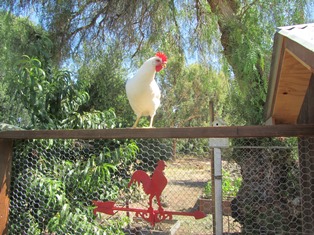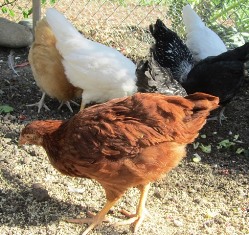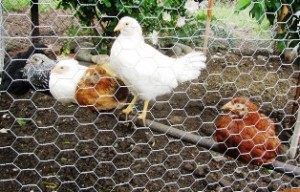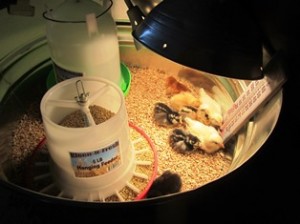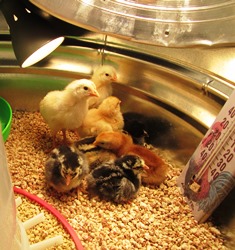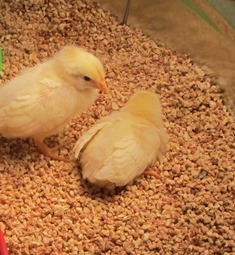Blog Archives
They’re Ba-a-c-k!
The sound of the chickens squawking propelled me upright in bed. The sun wasn’t up yet but there was a ruckus going on in the chicken house. And it didn’t sound pretty.
I leaped from bed, staggered to the window, pulled up the blind, and looked out.
The foxes had returned. One stood on its hind legs, pawing at the double layer of poultry wire screwed over the open chicken window.
I yelled, “Get out of there!” hoping the fox would leave . . . but it didn’t. It just made the chickens squawk louder.
Throwing on my robe, I raced to the patio where my red, rubber (indestructible) clogs waited for my feet to slide in. Grabbing the broom and a two-by-four, I raced to the chicken house, yelling all the way.
This time the fox paid attention, but showed no interest in retreating. I waved the broom and pounded my board against the metal garbage can (in which I keep the 25-pound bags of chicken feed). The noise did the trick. Off went the fox to join the other two.
The three disappeared into the wooded acre of land behind our property. Finally, my chickens settled down. I let them out for the day. One deposited her egg–not in the nesting box–but on the ground, as if too freaked out to go back inside the hen house. Well, can you blame her?
A Hawk Drops by to Visit the Chickens
Nightmarish as it seems, I didn’t fear the hawk swooping down from the pine tree onto the fence. Nor did I worry when it perched next to the chicken run this morning.
The poor chickens, who have been visited by foxes and other predators of late, deserve to be safe. To alleviate my own worries about the eight young layers and Mystery (the old Cochin), I’ve stretched poultry wire over the top of the run and strategically placed sheets of corrugated aluminum over potential entrance holes that animals could climb down, dig under, or fly through.
The brazen sharp-shinned hawk wasn’t deterred to see me this morning, but it didn’t approach the top of the run because there is no entry point from above.
Just as quickly as the hawk had landed on the fence, it flew away. The chickens went back running around the enclosed run, testing their own wings as they usually did each morning after being released from the hen house.
My girls are heritage breeds, so retain the flying ability that has been bred out of farm-factory chickens that are meant to only to lay eggs or be sold as meat to consumers.
I’ve lost chickens before to predators and ending up crying for days. I take full responsibility for raising my animals in a humane and loving way and I protect them. It’s the best way. For me, it’s the only way.
Outfoxing the Foxes
The chickens made such a ruckus this morning, I thought they were having trouble with a rodent in the hen house. My architect husband built the sturdy hen house off the ground.
He installed windows for air circulation and to cool off the chicken house at night. Good idea, we thought. Maybe not.

One of three gray foxes that have been checking out the chicken house at dawn and in the late evening
The windows open (to let out the heat) through screens. But foxes and open windows present a clear and present danger for the chickens.
When I first spotted the foxes on the uninhabited acre of land behind our farmette, I put extra poultry wire over the chicken run and over the hen house windows.
Each night, I secure the iron gate between the properties. The foxes were close this morning. I couldn’t say whether or not they’d go over the fence, but I took some shots with my camera before they spooked and left.
To outfox the foxes, I added extra roofing to the chicken run and inspected the fence all around to make sure there were no holes or weakened areas where the foxes could dig under.
We’ve placed a call to the local wildlife shelter and are hopeful that a representative can help us understand why the foxes are in an urban area (maybe in search of water and food during this intense drought) and whether nor not they will rescue the lovely little gray fox family, which is our hope.
Little Foxes on my Front Porch
The heat drove me from bed this morning around 6 a.m. Northern California is in the midst of a triple-digit heat wave and there’s not much relief at night.
I made coffee, as I always do as soon after rising, and peeked out the back sliding glass door. I can see into the chicken house because my husband installed windows. The chickens were still on the roost. I’d have time for a swallow or two of coffee.
Then I heard what sounded like a knock at the front door. Padding across the living room in bare feet, I opened it, half expecting to see my daughter (also an early riser; she likes making runs to Starbucks for her coffee).
It wasn’t my daughter. It was a small fox. The poor thing seemed as startled to see me as I was to see it.
When the fox bounded off the porch, I saw the other two. Yes, there were three–a whole family–in my front yard. Perhaps they came down from the hills of Mount Diablo to search for water or food . . . so back to the chickens I went.
Certain that there was no way for the foxes to get into the chicken run, I let the hens out; gave them food and water. Then, after searching the property for those little foxes, I went back to enjoy my coffee while the sun rose to begin roasting the Bay Area.
Gunshot Triggers Howls and Cackles in the Hood
Farm life isn’t always quiet. Night before last, a shot rang out around 11:00 p.m. It happened after some people in the neighborhood had engaged in a running argument, lasting hours.
My husband and I heard the arguing during our romantic dinner on the patio. His birthday is tomorrow and we celebrate birthdays all week, you see.
Hubby said he knew the sound of gunshots when he heard them. He was even more certain he’d heard the words, “We got to get out of here!” I was tempted to dive under the bed because people on the run with guns . . . well, that could be dangerous.
In the dark, you don’t know what has happened. I write mysteries. I’m thinking, “is there a body on the adjacent property?”
Three uniformed police officers arrive with nightsticks in their duty belts and guns in their holsters. With their flashlights drawn and turned on, they searched for a way into fortress that the neighbor has built or a means to see behind the tarps the neighbor has strung to hide his backyard and sheds.
Over the barking of the neighbor’s pit bull, I heard one officer tell the others, “This is like the Beverly Hillbillies. We’re notifying Code Enforcement.”
Glad it wasn’t our place they were talking about. We’ve been renovating . . . but neatly. Still, there’s the unfinished porch, the pile of lumber . . . .
I watched the erratic beams of their flashlights as they searched. Then . . . here they come, lights bobbing, down our driveway. They want to see if they can penetrate the fortress of the Beverly Hillbillies from another direction. Our house is in close proximity.
My husband went searching for a ladder. Call me silly, but I thought it would be the tall, thin officer, who would climb up. No, that would be too logical. It was the short, chunky one scaling into the heights, disappearing into the elm tree. Did I mention the tree has an almost impenetrable canopy in summer? Not surprising that he couldn’t see anything.
The officers decided on a look-see from the rear. My hubby guided them through a field, past the apiary and chicken house.
Roosting chickens are usually quiet. No doubt, you’ve heard the expression, “Going to bed with the chickens, rising with the rooster.” To say my hens were alarmed might be an understatement. They’d been roused from their slumber and cackled like there was no tomorrow. I realize there’s a bit of irony in the fact that our place is called the Henny Penny Farmette after Chicken Little’s story about the acorn falling on her head. This could have been the sky falling. They cackled like it was.
The deafening cackles agitated the neighbor’s pit bull, whose incessant barking got all the dogs in the hood howling. A fire engine shot by, sirens blaring. I took an aspirin, waited for my husband to return and the officers to leave.
Back in bed, who could sleep? I worried about when about when Code Enforcement might show up to cite the Beverly Hillbillies. Would the officers look over the fence and cite us as well? Code Enforcement aside, a gun-toter could hide behind our pile of porch lumber. We gotta get that porch finished.
But, like I said, it’s my husband’s birthday. He’s feeling romantic this week and not easily pushed. See my conundrum?
You Can’t Hurry a Chicken into Laying an Egg
I brought home my little flock of baby chicks on March 7. Yesterday marked 16 weeks or four months. That’s important because that’s when the feed store told me I could start expecting eggs from my White Leghorns. Not with mine. They are taking their own sweet time.
The Rhode Island Red can take between 20 and 26 weeks–or so I’ve been told–to start laying. Mine just wants to forage in the yard, follow me around, get in my face, and eat any extra blueberries that I didn’t consume with my morning yogurt and honey. I had a talk with her yesterday about how I’m expecting some eggs in return for all those blueberries.
My flock also includes a Buff Orpington, a Black Sex Link, an Ameraucana, and two Silver Laced Wyandottes, the latter is an old heritage breed can take up to 32 weeks to begin laying. So maybe around Halloween, I’ll find their first offerings.
In anticipation of the big egg-laying event, I’ve switched the chicken food to a crumble for laying hens. Tomorrow I will buy some oyster shell calcium for strong egg shells. I’ve also tucked smooth, wooden eggs into their nesting boxes with some soft straw, hoping to encourage the girls to get with it.
Their voices have now changed from the peep, peep, to cluck, cluck. But I’ve yet to hear that loud cackle that tells me an egg has been laid. Sometimes I’ll see one of some serious squatting and get excited. Okay, this is it. But so far, it isn’t.
So the watch goes on. You can’t hurry a chicken who isn’t ready to produce eggs. So in the meantime, I’ll be eating a lot more yogurt and berries for breakfast.
Dealing with a Flock of Stressed-Out, Feathered-Out Chicks
Now that the weather has turned warm here in Northern California, I have moved my baby chicks from the huge box in my kitchen to our newly constructed chicken house. I don’t know for certain, but I think they were feeling stressed out in the box and I was stressed from the noise and their behaviors of pecking each other and trying to fly out of the box.
The hen house has two windows that open and close for ventilation, nesting boxes, a front door for my access, a back exit door with stairs for the chickens to enter and leave, and a couple of perches inside and out. We wired a poultry screen over the top of the chicken run because of the predatory habits of local hawks.
Our chicks range in age from eight and ten weeks and are all feathered out. I feed them medicated crumble and provide fresh water daily. To ensure strong legs, I cover the chicken house floor with a bed of dried, crushed corn cob. I also have stuffed straw into the three nesting boxes so that when the chickens are ready to begin laying, they’ll have a bed ready.
The chicks are growing so fast, their girth and height seems to double every week. The bulk of their diet is crumble, but with an occasional treat such as shredded fresh lettuce and spinach leaves. Their activities and often-flighty behaviors are notable for chickens. They take dust baths, scratch the earth for grubs and worms, run at each other while seemingly intent on crashing only to avert at the last minute, perch together to roost, and peck their housemates. Oh, the pecking!
Guess which chicken is the most aggressive pecker from my flock that includes White Leghorn, Silver-Laced Wyandotte, Buff Orpington, Rhode Island Red, Black Sex Link, and an Ameraucana. Turns out,in my flock, the most aggression is shown by the Buff Orpington.
From day one, “Buffy” has pecked the quiet Ameraucana. Before the Ameraucana had feathered out, blood would flow from her back from Buffy’s senseless pecking. I tried to separate them, giving Buffy time outs and hoping to stop her behavior. It seemed to work . . . or, maybe I was just imagining it was.
I placed a dab of antibiotic cream on the back of the Ameraucana and within days, her pecking wound healed and now she’s feathered again over the wound. The move to the chicken house reduced the stress of living out of a box in the kitchen. Now the chickens seem to get along fine, even enjoying their life in the hen house.
Last night, Buff huddled up next to the Ameraucana on the roost and this morning I saw the two of them taking a dust bath together. Chicken stress relief. My stress relief. It’s a beautiful thing!
Chicklet Therapy: Raising Baby Chicks
I’m raising a flock of baby chicks in a tub in my kitchen. Watching them is nothing short of a stress-busting exercise. Not only do they provide endless entertainment, but they already show individual temperaments and personality traits that can’t help but make you smile.
Some people raise backyard chickens for both meat and eggs. Others want only eggs (I’m in that group). And there are those who love keeping the more exotic breeds–imagine feathered legs and toes, cheek muffs, beards, and strange-looking combs.
There are so many breeds, it’s hard to keep track of them all. For example, there are the standards like the White Leghorns and Rhode Island Reds; the exotics like the Faverolles (with their five toes, feathered feet, and fluffy beards and muffs), and heritage chickens.
Traditional breeds or “heritage” chickens aren’t as popular as they once were, so their numbers are declining. Some are even considered Of the heritage chickens whose numbers are declining so rapidly that they are considered globally endangered. They include Campines, Andalusians, Buttercups, Catalanas, Sumatras, and other breeds.
My baby chick choices include a Rhode Island Red, a Buff Orpington, two Silver-Laced Wyandottes, two White Leghorns, a Black Sex Link, and an Ameraucana (who lays blue-green eggs). All are known to be good layers, although some are more productive than others.
Egg production can go down during periods of molting (losing their feathers) or broodiness (sitting on the eggs as though they will hatch, which they won’t because without a rooster, the eggs are not fertile). Also, egg production can decline during winter when the daylight hours are shorter.
The following guidance comes from my local feed and pet supply store, Concord Feed, Pet, and Livestock Supply. See, http://www.concordfeed.com. The store’s capable staff are all extremely knowledgeable about chicks. Here are the guidelines.
1. The environment must be clean, warm, and dry (no drafts). Consider a brooder’s box or large galvanized tub filled with dry and mold-free bedding such as corn cob shavings (Bed-O-Cobb is a good one). Avoid smooth, slick surfaces that can cause leg damage.
2. They must have room to roam. The rule of thumb is 1 square foot per chick; when they are six weeks and older, given them 2 square feet per bird.
3. Day-old chicks need 90 to 95 degrees Fahrenheit. To achieve this, attach a heat lamp or light bulb about 20 inches above the chicks. When cold, the baby chicks tend to huddle together under the lamp for warmth; when hot, the chicks move to the corners. You will want to reduce the temperature created by the heat lamp by five degrees each week until you reach the ideal temperature of 65 degrees Fahrenheit. Simply move the lamp further away from the chicks.
4. Hydrate the chicks with a one-quart of fresh, cool water in a dispenser that is changed daily (or more often if they scratch bedding or food into it). A quart container will provide enough water for 25 chicks.
5. Feed the babies with a chick starter until they are 16 to 20 weeks old. By that age, they should be feathered completely. Then begin giving the hens a laying feed to help them produce strong-shelled eggs and provide them with the nutrients they require.
By following these guidelines, I think I’ll be able to have eggs from my little hens by August or September this year, barring any of them turning out to be roosters. In case I must give him up (some cities don’t allow roosters), which I wouldn’t want to do, I’ve already talked to the feed store about rooster rescue organization. For helpful information about keeping chickens, see http://www.backyardchickens.com/
Certain Plants And Chickens Don’t Go Together
Chickens are curious creatures. Spend a hour watching them scratch, poke, and peck and you’ll see what I mean.
I’ve never lost a free-range chicken because of something it ate; but it seems as though they’ll eat anything. It got me thinking that a variety of plants commonly grown in landscapes and backyard gardens could make chickens ill if they ate the berries, nuts, or leaves of those plants.
The following represents a small sampling of common plants that could make your feathered friends sick or even poison them.
- Acorn
- Alfalfa
- Azalea
- Daffodil
- Eggplant
- Foxglove
- Hemlock
- Jasmine
- Jimson Weed
- Lamb’s Quarters
- Lantana
- Milkweed
- Nicotiana (tobacco)
- Oleander
- Oxalis
- Poison Ivy
- Poison Oak
- Pokeweed
- Pyracantha
- Red Maple
- Rhubarb
- Sweet Pea
- Tulip
- Wild Onion
- Wisteria
Chickens are foraging birds and have good natural instincts. They will taste a plant and if something isn’t right, they’ll likely leave it. If you allow them to forage for themselves in pasture, more often than not, they’ll eschew the poisonous plants in your garden or landscape for the rich diversity of what they find in open pastureland.
If Your Chickens Aren’t Cold Hardy, What Can You Do?
Chickens that can tolerate extreme cold are considered cold-hardy. The Dominique, Hamburg, Langshan, Sussex, and Wyandotte breeds are considered chill tolerant (even cold-hardy) but breeds such as Crevecoeur and Catalana are less tolerant of temperature extremes. So are Bantams and some breeds with large, single combs.
The chickens generate body heat that helps alleviate the cold temperature of a coop. They also wear feathered coats and will huddle together for warmth. A hen house that has insulation and perhaps a south-facing window that captures the warmth of a winter sun can also mitigate extreme cold.
Still, if you live in an area where the temps are below freezing, where it snows, and where the wind contributes to the chill, you might want to hang an ordinary light bulb (40-60 watts) or a 50-watt red bulb if you worry about frost-bitten chickens on those coldest nights.
Put that lamp on a timer. But beware of hanging any electric light that could get knocked down. It could set your coop on fire. And cold-tolerant breeds probably don’t need the extra heat anyway.
Perhaps equally, if not more, important are the chickens’ need for fresh water, ventilation, and a dry environment during winter. You don’t want the chickens roosting in a draft, but you do need ventilation in the coop, for example, via egg-access doors, windows, or ventilation holes with screens. They also need a dry environment.
If the coop isn’t insulated, you might stack bales of straw or hay along the walls and scatter pine shavings if your coop has an earthen floor that becomes cold or frozen.

This chicken house has egg access doors, a human door, a window, and is insulated; the art is optional.
Cold-hardy chickens probably will make it through most frosty nights with few to no problems. Your best tool is your ability to observe your chickens for problems. Oh, and you might want to place a thermometer inside the coop for an accurate measurement about how cold it really gets when the ladies (and rooster, too) are all inside.
Don’t judge your chickens’ endurance for cold by your own.
 Facebook
Facebook Goodreads
Goodreads LinkedIn
LinkedIn Meera Lester
Meera Lester Twitter
Twitter




